BMW X3 2015 F25 Owner's Manual
Manufacturer: BMW, Model Year: 2015, Model line: X3, Model: BMW X3 2015 F25Pages: 257, PDF Size: 5.26 MB
Page 101 of 257
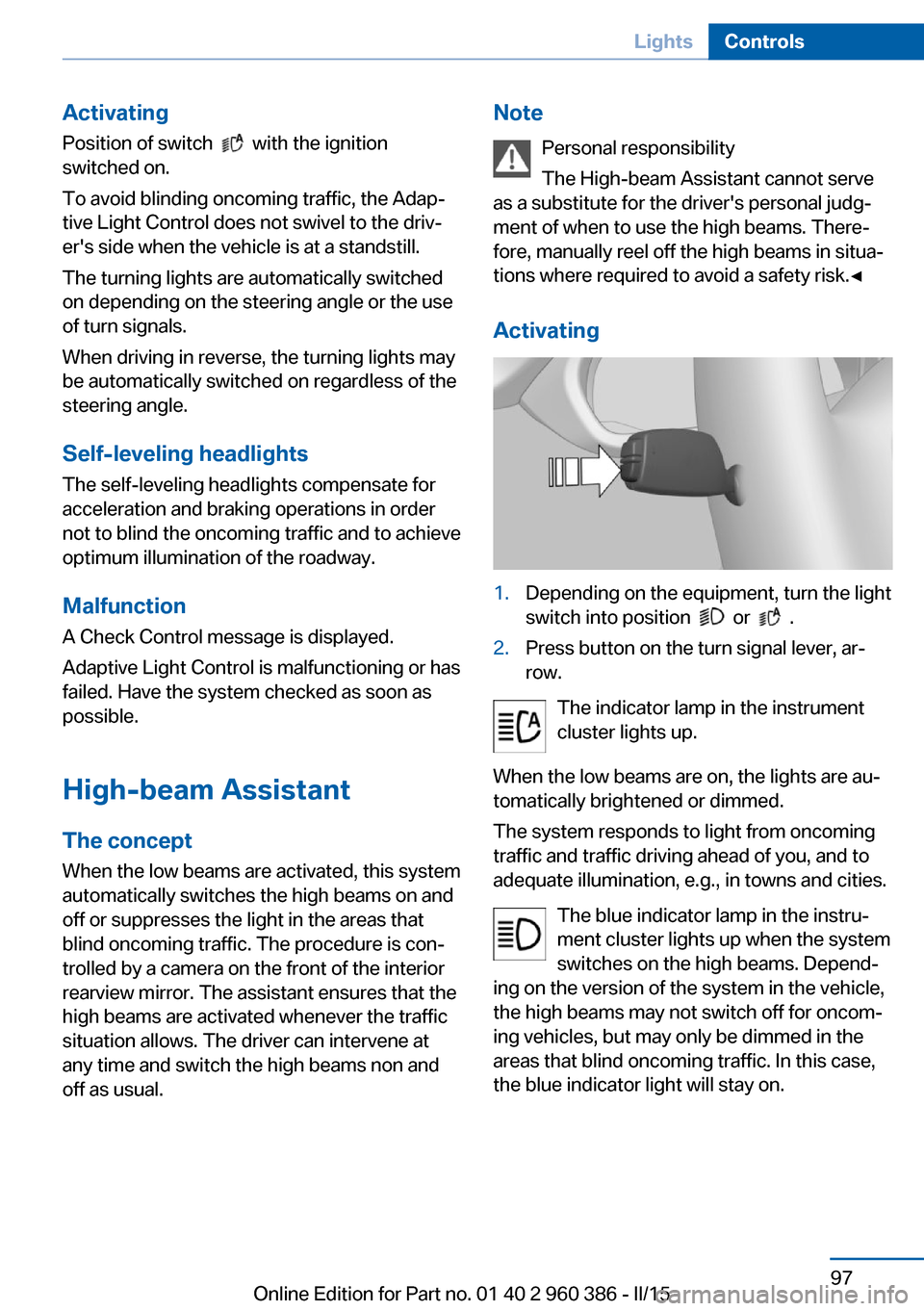
ActivatingPosition of switch
with the ignition
switched on.
To avoid blinding oncoming traffic, the AdapŌĆÉ
tive Light Control does not swivel to the drivŌĆÉ
er's side when the vehicle is at a standstill.
The turning lights are automatically switched
on depending on the steering angle or the use
of turn signals.
When driving in reverse, the turning lights may
be automatically switched on regardless of the
steering angle.
Self-leveling headlights The self-leveling headlights compensate for
acceleration and braking operations in order
not to blind the oncoming traffic and to achieve
optimum illumination of the roadway.
Malfunction A Check Control message is displayed.
Adaptive Light Control is malfunctioning or has
failed. Have the system checked as soon as
possible.
High-beam Assistant
The concept When the low beams are activated, this system
automatically switches the high beams on and
off or suppresses the light in the areas that
blind oncoming traffic. The procedure is conŌĆÉ
trolled by a camera on the front of the interior
rearview mirror. The assistant ensures that the
high beams are activated whenever the traffic
situation allows. The driver can intervene at
any time and switch the high beams non and
off as usual.
Note
Personal responsibility
The High-beam Assistant cannot serve
as a substitute for the driver's personal judgŌĆÉ
ment of when to use the high beams. ThereŌĆÉ
fore, manually reel off the high beams in situaŌĆÉ
tions where required to avoid a safety risk.ŌŚĆ
Activating1.Depending on the equipment, turn the light
switch into position
or .
2.Press button on the turn signal lever, arŌĆÉ
row.
The indicator lamp in the instrument
cluster lights up.
When the low beams are on, the lights are auŌĆÉ
tomatically brightened or dimmed.
The system responds to light from oncoming
traffic and traffic driving ahead of you, and to
adequate illumination, e.g., in towns and cities.
The blue indicator lamp in the instruŌĆÉ
ment cluster lights up when the system
switches on the high beams. DependŌĆÉ
ing on the version of the system in the vehicle, the high beams may not switch off for oncomŌĆÉ
ing vehicles, but may only be dimmed in the
areas that blind oncoming traffic. In this case,
the blue indicator light will stay on.
Seite 97LightsControls97
Online Edition for Part no. 01 40 2 960 386 - II/15
Page 102 of 257
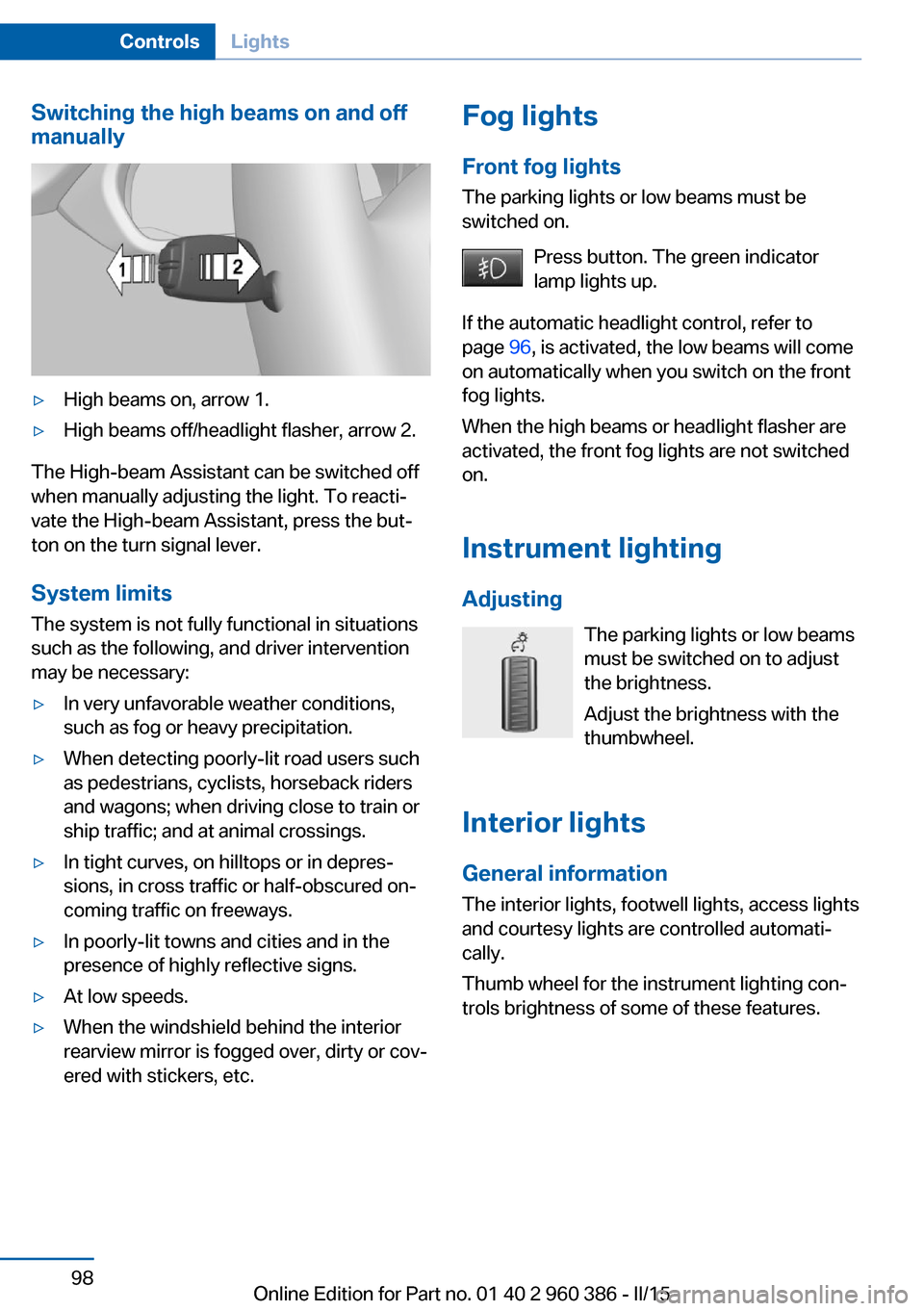
Switching the high beams on and off
manuallyŌ¢ĘHigh beams on, arrow 1.Ō¢ĘHigh beams off/headlight flasher, arrow 2.
The High-beam Assistant can be switched off
when manually adjusting the light. To reactiŌĆÉ
vate the High-beam Assistant, press the butŌĆÉ
ton on the turn signal lever.
System limits
The system is not fully functional in situations such as the following, and driver intervention
may be necessary:
Ō¢ĘIn very unfavorable weather conditions,
such as fog or heavy precipitation.Ō¢ĘWhen detecting poorly-lit road users such
as pedestrians, cyclists, horseback riders
and wagons; when driving close to train or
ship traffic; and at animal crossings.Ō¢ĘIn tight curves, on hilltops or in depresŌĆÉ
sions, in cross traffic or half-obscured onŌĆÉ
coming traffic on freeways.Ō¢ĘIn poorly-lit towns and cities and in the
presence of highly reflective signs.Ō¢ĘAt low speeds.Ō¢ĘWhen the windshield behind the interior
rearview mirror is fogged over, dirty or covŌĆÉ
ered with stickers, etc.Fog lights
Front fog lights
The parking lights or low beams must be
switched on.
Press button. The green indicator
lamp lights up.
If the automatic headlight control, refer to
page 96, is activated, the low beams will come
on automatically when you switch on the front
fog lights.
When the high beams or headlight flasher are
activated, the front fog lights are not switched
on.
Instrument lighting Adjusting The parking lights or low beams
must be switched on to adjust
the brightness.
Adjust the brightness with the
thumbwheel.
Interior lights
General information The interior lights, footwell lights, access lights
and courtesy lights are controlled automatiŌĆÉ
cally.
Thumb wheel for the instrument lighting conŌĆÉ
trols brightness of some of these features.Seite 98ControlsLights98
Online Edition for Part no. 01 40 2 960 386 - II/15
Page 103 of 257
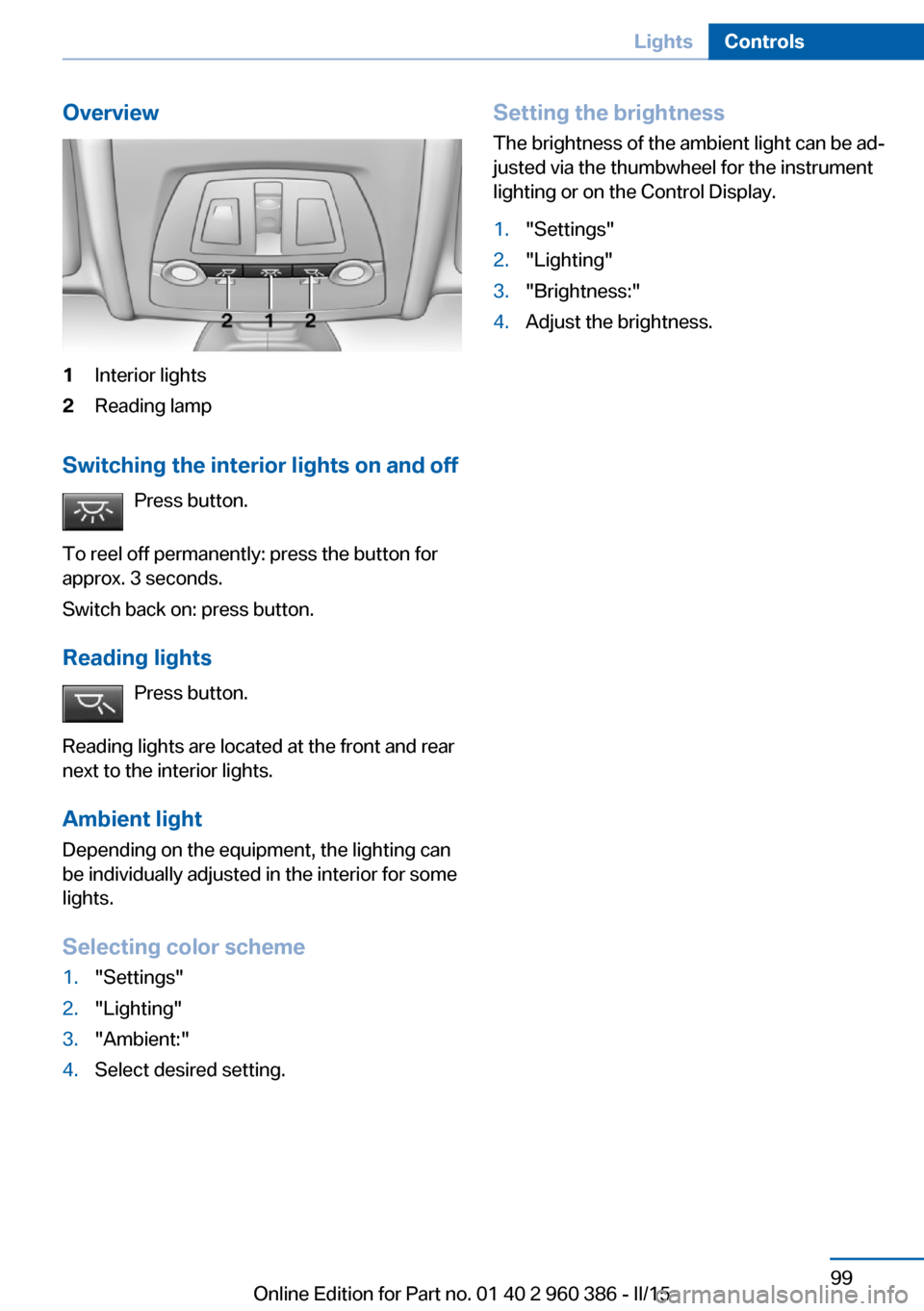
Overview1Interior lights2Reading lamp
Switching the interior lights on and offPress button.
To reel off permanently: press the button for
approx. 3 seconds.
Switch back on: press button.
Reading lights Press button.
Reading lights are located at the front and rear
next to the interior lights.
Ambient light Depending on the equipment, the lighting can
be individually adjusted in the interior for some
lights.
Selecting color scheme
1."Settings"2."Lighting"3."Ambient:"4.Select desired setting.Setting the brightness
The brightness of the ambient light can be adŌĆÉ
justed via the thumbwheel for the instrument
lighting or on the Control Display.1."Settings"2."Lighting"3."Brightness:"4.Adjust the brightness.Seite 99LightsControls99
Online Edition for Part no. 01 40 2 960 386 - II/15
Page 104 of 257

SafetyVehicle features and options
This chapter describes all standard, country-
specific and optional features offered with the
series. It also describes features that are not
necessarily available in your car, e. g., due tothe selected options or country versions. This
also applies to safety-related functions and
systems. The respectively applicable country
provisions must be observed when using the
respective features and systems.
Airbags
1Front airbag, driver2Front airbag, front passenger3Head airbag4Side airbag5Knee airbagsFront airbags
Front airbags help protect the driver and front
passenger by responding to frontal impacts in
which safety belts alone would not provide adŌĆÉ
equate restraint.Side airbags
In a lateral impact, the side airbag supports the
side of the body in the chest and lap area.
Head airbags
In a lateral impact, the head airbag supports
the head.Seite 100ControlsSafety100
Online Edition for Part no. 01 40 2 960 386 - II/15
Page 105 of 257
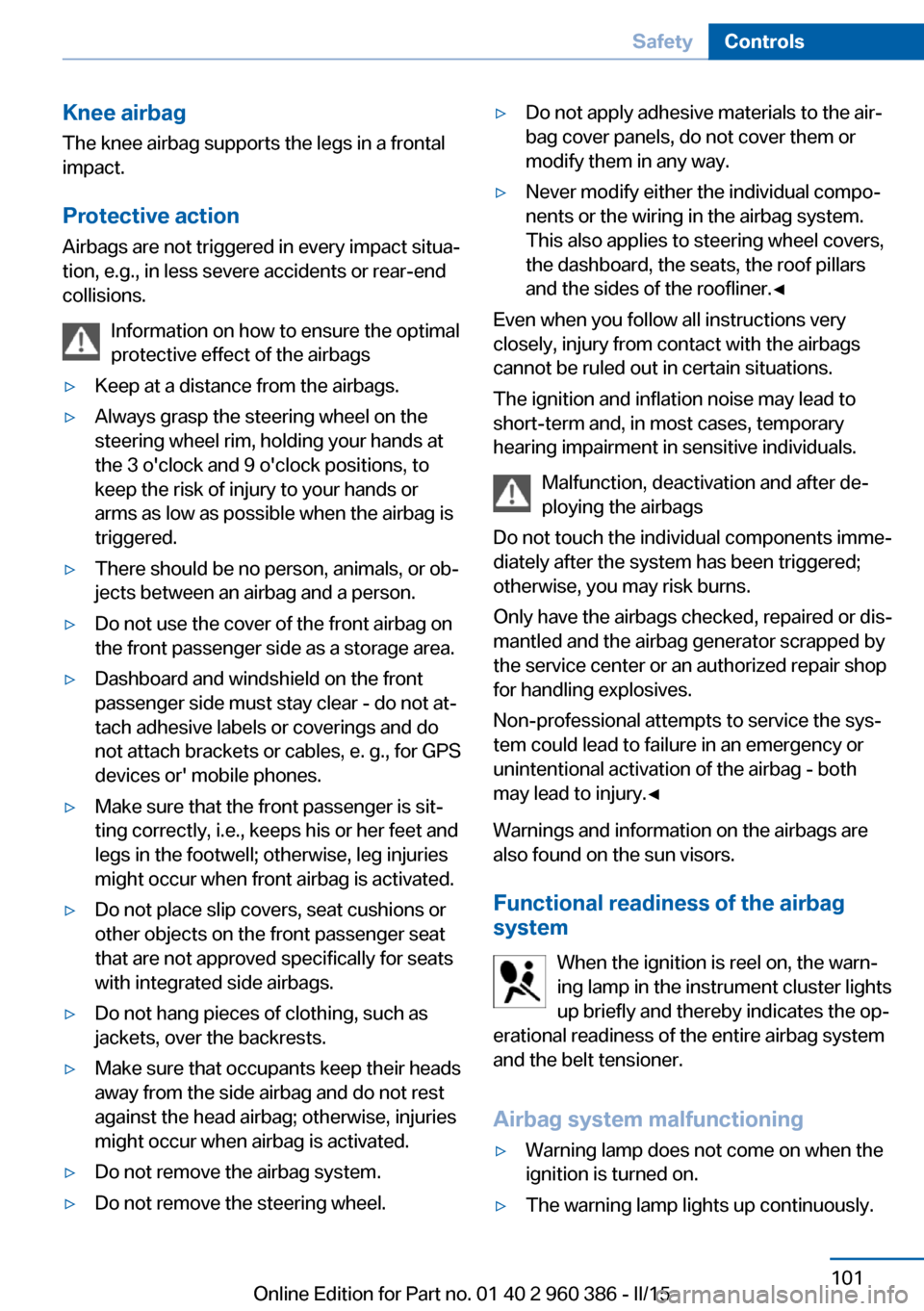
Knee airbagThe knee airbag supports the legs in a frontal
impact.
Protective action
Airbags are not triggered in every impact situaŌĆÉ
tion, e.g., in less severe accidents or rear-end
collisions.
Information on how to ensure the optimal
protective effect of the airbagsŌ¢ĘKeep at a distance from the airbags.Ō¢ĘAlways grasp the steering wheel on the
steering wheel rim, holding your hands at
the 3 o'clock and 9 o'clock positions, to
keep the risk of injury to your hands or
arms as low as possible when the airbag is
triggered.Ō¢ĘThere should be no person, animals, or obŌĆÉ
jects between an airbag and a person.Ō¢ĘDo not use the cover of the front airbag on
the front passenger side as a storage area.Ō¢ĘDashboard and windshield on the front
passenger side must stay clear - do not atŌĆÉ
tach adhesive labels or coverings and do
not attach brackets or cables, e. g., for GPS
devices or' mobile phones.Ō¢ĘMake sure that the front passenger is sitŌĆÉ
ting correctly, i.e., keeps his or her feet and
legs in the footwell; otherwise, leg injuries
might occur when front airbag is activated.Ō¢ĘDo not place slip covers, seat cushions or
other objects on the front passenger seat
that are not approved specifically for seats
with integrated side airbags.Ō¢ĘDo not hang pieces of clothing, such as
jackets, over the backrests.Ō¢ĘMake sure that occupants keep their heads
away from the side airbag and do not rest
against the head airbag; otherwise, injuries
might occur when airbag is activated.Ō¢ĘDo not remove the airbag system.Ō¢ĘDo not remove the steering wheel.Ō¢ĘDo not apply adhesive materials to the airŌĆÉ
bag cover panels, do not cover them or
modify them in any way.Ō¢ĘNever modify either the individual compoŌĆÉ
nents or the wiring in the airbag system.
This also applies to steering wheel covers,
the dashboard, the seats, the roof pillars
and the sides of the roofliner.ŌŚĆ
Even when you follow all instructions very
closely, injury from contact with the airbags
cannot be ruled out in certain situations.
The ignition and inflation noise may lead to
short-term and, in most cases, temporary
hearing impairment in sensitive individuals.
Malfunction, deactivation and after deŌĆÉ
ploying the airbags
Do not touch the individual components immeŌĆÉ
diately after the system has been triggered;
otherwise, you may risk burns.
Only have the airbags checked, repaired or disŌĆÉ
mantled and the airbag generator scrapped by
the service center or an authorized repair shop
for handling explosives.
Non-professional attempts to service the sysŌĆÉ
tem could lead to failure in an emergency or
unintentional activation of the airbag - both
may lead to injury.ŌŚĆ
Warnings and information on the airbags are also found on the sun visors.
Functional readiness of the airbag
system
When the ignition is reel on, the warnŌĆÉ
ing lamp in the instrument cluster lights
up briefly and thereby indicates the opŌĆÉ
erational readiness of the entire airbag system
and the belt tensioner.
Airbag system malfunctioning
Ō¢ĘWarning lamp does not come on when the
ignition is turned on.Ō¢ĘThe warning lamp lights up continuously.Seite 101SafetyControls101
Online Edition for Part no. 01 40 2 960 386 - II/15
Page 106 of 257
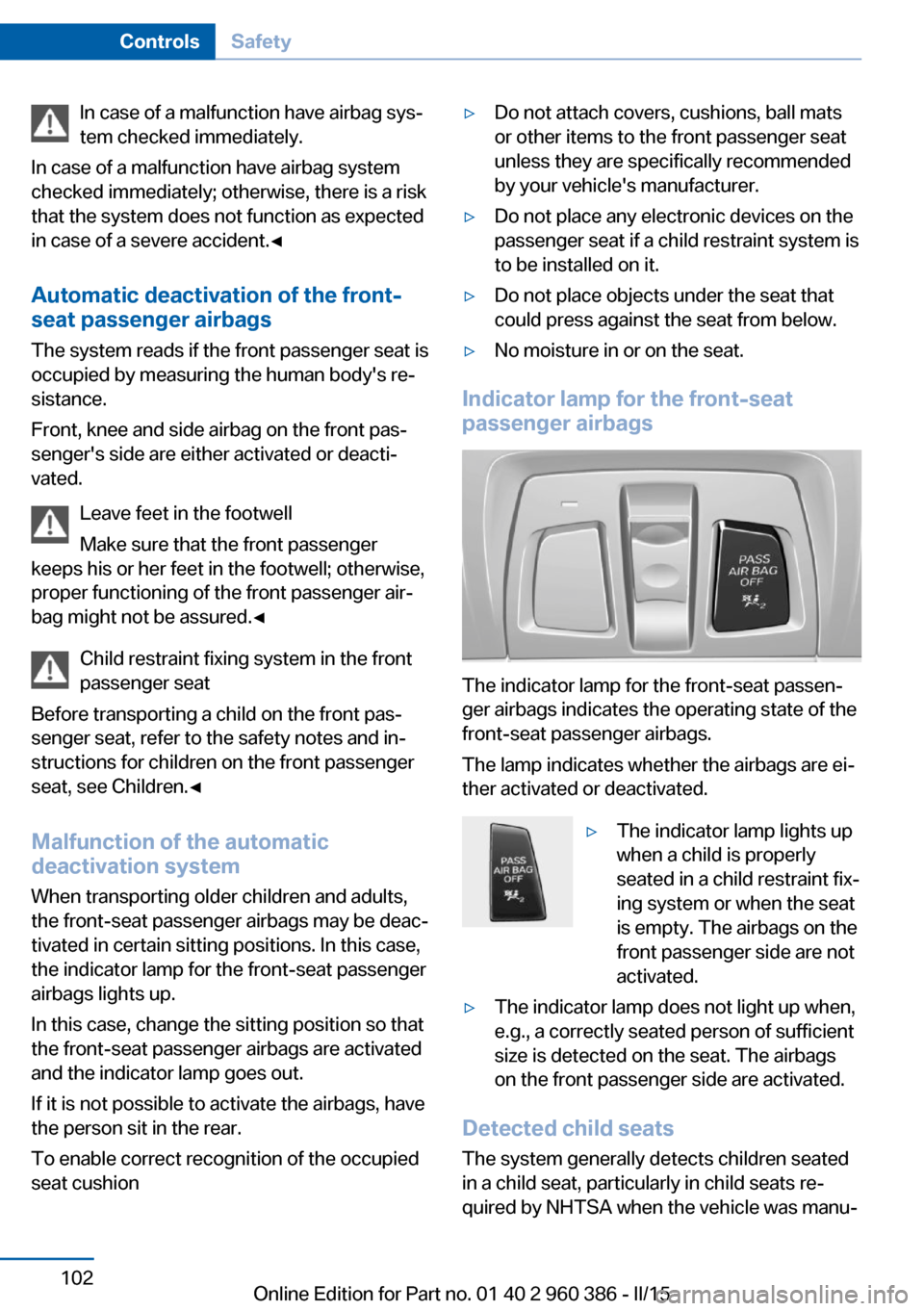
In case of a malfunction have airbag sysŌĆÉ
tem checked immediately.
In case of a malfunction have airbag system
checked immediately; otherwise, there is a risk
that the system does not function as expected
in case of a severe accident.ŌŚĆ
Automatic deactivation of the front-
seat passenger airbags
The system reads if the front passenger seat is
occupied by measuring the human body's reŌĆÉ
sistance.
Front, knee and side airbag on the front pasŌĆÉ
senger's side are either activated or deactiŌĆÉ
vated.
Leave feet in the footwell
Make sure that the front passenger
keeps his or her feet in the footwell; otherwise,
proper functioning of the front passenger airŌĆÉ
bag might not be assured.ŌŚĆ
Child restraint fixing system in the front
passenger seat
Before transporting a child on the front pasŌĆÉ
senger seat, refer to the safety notes and inŌĆÉ
structions for children on the front passenger
seat, see Children.ŌŚĆ
Malfunction of the automatic
deactivation system
When transporting older children and adults,
the front-seat passenger airbags may be deacŌĆÉ
tivated in certain sitting positions. In this case,
the indicator lamp for the front-seat passenger
airbags lights up.
In this case, change the sitting position so that
the front-seat passenger airbags are activated
and the indicator lamp goes out.
If it is not possible to activate the airbags, have
the person sit in the rear.
To enable correct recognition of the occupied
seat cushionŌ¢ĘDo not attach covers, cushions, ball mats
or other items to the front passenger seat
unless they are specifically recommended
by your vehicle's manufacturer.Ō¢ĘDo not place any electronic devices on the
passenger seat if a child restraint system is
to be installed on it.Ō¢ĘDo not place objects under the seat that
could press against the seat from below.Ō¢ĘNo moisture in or on the seat.
Indicator lamp for the front-seat
passenger airbags
The indicator lamp for the front-seat passenŌĆÉ
ger airbags indicates the operating state of the
front-seat passenger airbags.
The lamp indicates whether the airbags are eiŌĆÉ
ther activated or deactivated.
Ō¢ĘThe indicator lamp lights up
when a child is properly
seated in a child restraint fixŌĆÉ
ing system or when the seat
is empty. The airbags on the
front passenger side are not
activated.Ō¢ĘThe indicator lamp does not light up when,
e.g., a correctly seated person of sufficient
size is detected on the seat. The airbags
on the front passenger side are activated.
Detected child seats
The system generally detects children seated
in a child seat, particularly in child seats reŌĆÉ
quired by NHTSA when the vehicle was manuŌĆÉ
Seite 102ControlsSafety102
Online Edition for Part no. 01 40 2 960 386 - II/15
Page 107 of 257

factured. After installing a child seat, make
sure that the indicator lamp for the front-seat
passenger airbags lights up. This indicates
that the child seat has been detected and the
front-seat passenger airbags are not activated.
Strength of the driver's and front-seat
passenger airbag
The explosive power that activates driver's/
front passenger's airbags very much depends
on the positions of the driver's/front passengŌĆÉ
er's seat.
With a respective message appearing on ConŌĆÉ
trol Display calibrate the front seats to keep
the accuracy of this function over the long-
term.
Calibrating the front seats A corresponding message appears on the
Control Display.1.Press the reel and move the respective
seat all the way forward.2.Press the reel forward again. The seat still
moves forward slightly.3.Readjust the seat to the desired position.
The calibration procedure is completed when
the message on the Control Display disapŌĆÉ
pears.
If the message continues to be displayed, reŌĆÉ
peat the calibration.
If the message does not disappear after a reŌĆÉ
peat calibration, have the system checked as
soon as possible.
Unobstructed area of movement
Ensure that the area of movement of the
seats is unobstructed to avoid personal injury
or damage to objects.ŌŚĆ
Tire Pressure Monitor TPM
The concept The system monitors tire inflation pressure in
the four mounted tires. The system warns you
if there is a significant loss of pressure in one
or more tires. For this purpose, sensors in the
tire valves measure the tire inflation pressure
and tire temperature.
Hints Tire damage due to external factors
Sudden tire damage caused by external
circumstances cannot be recognized in adŌĆÉ
vance.ŌŚĆ
With use of the system observe further inforŌĆÉ
mation found under Tire inflation pressure, reŌĆÉ
fer to page 197.
Functional requirements
The system must have been reset with the
correct tire inflation pressure; otherwise, reliaŌĆÉ
ble signaling of tire inflation pressure loss is
not assured.
Reset the system after each adjustment of the
tire inflation pressure and after every tire or
wheel change.
Always use wheels with TPM electronics to
ensure that the system will operate properly.
Status display The current status of the Tire Pressure MoniŌĆÉ
tor TPM can be displayed on the Control DisŌĆÉ
play, e.g., whether or not the TPM is active.1."Vehicle info"2."Vehicle status"3. "Tire Pressure Monitor (TPM)"
The status is displayed.
Seite 103SafetyControls103
Online Edition for Part no. 01 40 2 960 386 - II/15
Page 108 of 257
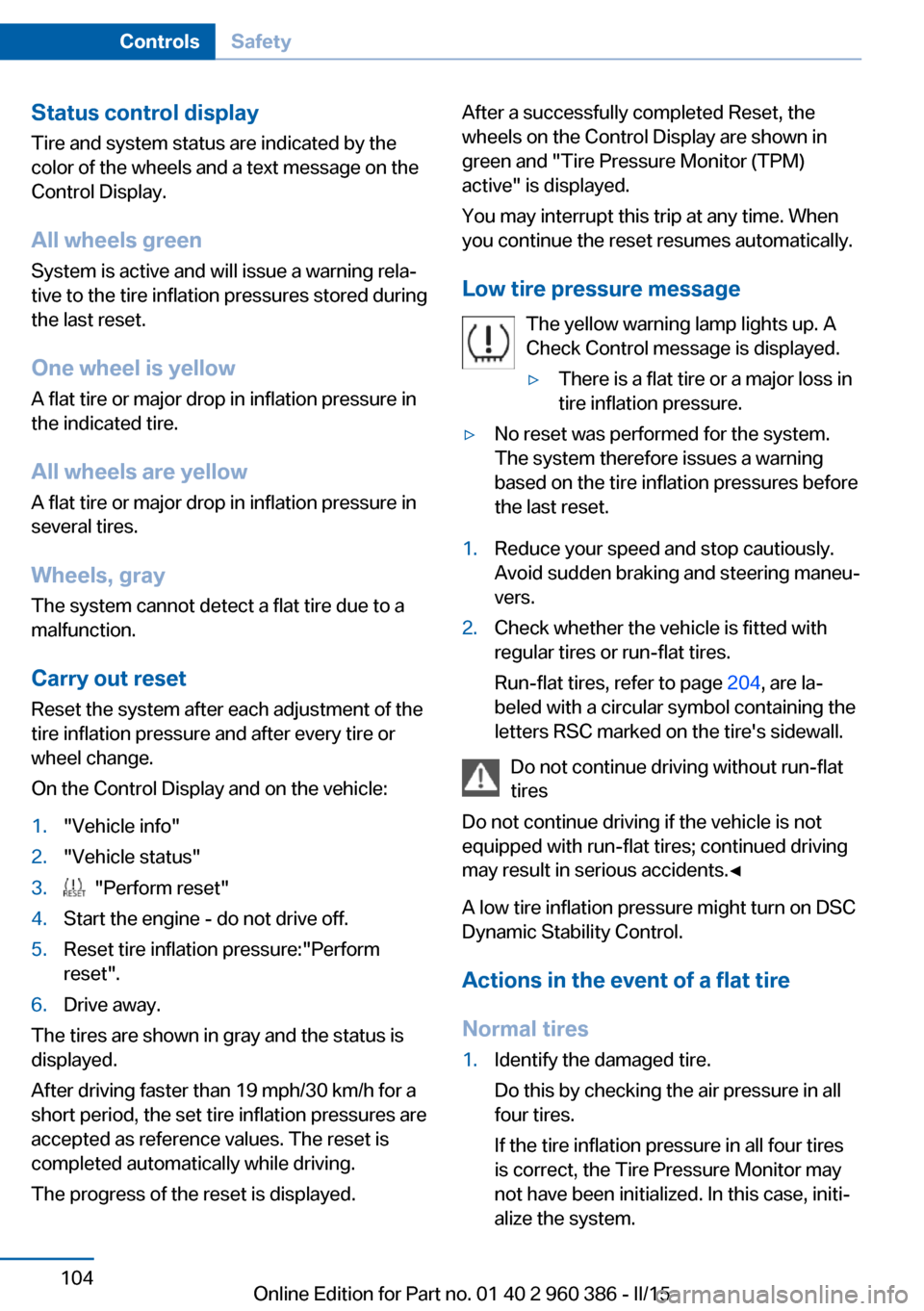
Status control displayTire and system status are indicated by the
color of the wheels and a text message on the
Control Display.
All wheels green System is active and will issue a warning relaŌĆÉ
tive to the tire inflation pressures stored during
the last reset.
One wheel is yellow A flat tire or major drop in inflation pressure in
the indicated tire.
All wheels are yellow A flat tire or major drop in inflation pressure in
several tires.
Wheels, gray The system cannot detect a flat tire due to a
malfunction.
Carry out reset
Reset the system after each adjustment of the
tire inflation pressure and after every tire or
wheel change.
On the Control Display and on the vehicle:1."Vehicle info"2."Vehicle status"3. "Perform reset"4.Start the engine - do not drive off.5.Reset tire inflation pressure:"Perform
reset".6.Drive away.
The tires are shown in gray and the status is
displayed.
After driving faster than 19 mph/30 km/h for a
short period, the set tire inflation pressures are
accepted as reference values. The reset is
completed automatically while driving.
The progress of the reset is displayed.
After a successfully completed Reset, the
wheels on the Control Display are shown in
green and "Tire Pressure Monitor (TPM)
active" is displayed.
You may interrupt this trip at any time. When
you continue the reset resumes automatically.
Low tire pressure message The yellow warning lamp lights up. A
Check Control message is displayed.Ō¢ĘThere is a flat tire or a major loss in
tire inflation pressure.Ō¢ĘNo reset was performed for the system.
The system therefore issues a warning
based on the tire inflation pressures before
the last reset.1.Reduce your speed and stop cautiously.
Avoid sudden braking and steering maneuŌĆÉ
vers.2.Check whether the vehicle is fitted with
regular tires or run-flat tires.
Run-flat tires, refer to page 204, are laŌĆÉ
beled with a circular symbol containing the
letters RSC marked on the tire's sidewall.
Do not continue driving without run-flat
tires
Do not continue driving if the vehicle is not
equipped with run-flat tires; continued driving
may result in serious accidents.ŌŚĆ
A low tire inflation pressure might turn on DSC
Dynamic Stability Control.
Actions in the event of a flat tireNormal tires
1.Identify the damaged tire.
Do this by checking the air pressure in all
four tires.
If the tire inflation pressure in all four tires
is correct, the Tire Pressure Monitor may
not have been initialized. In this case, initiŌĆÉ
alize the system.Seite 104ControlsSafety104
Online Edition for Part no. 01 40 2 960 386 - II/15
Page 109 of 257
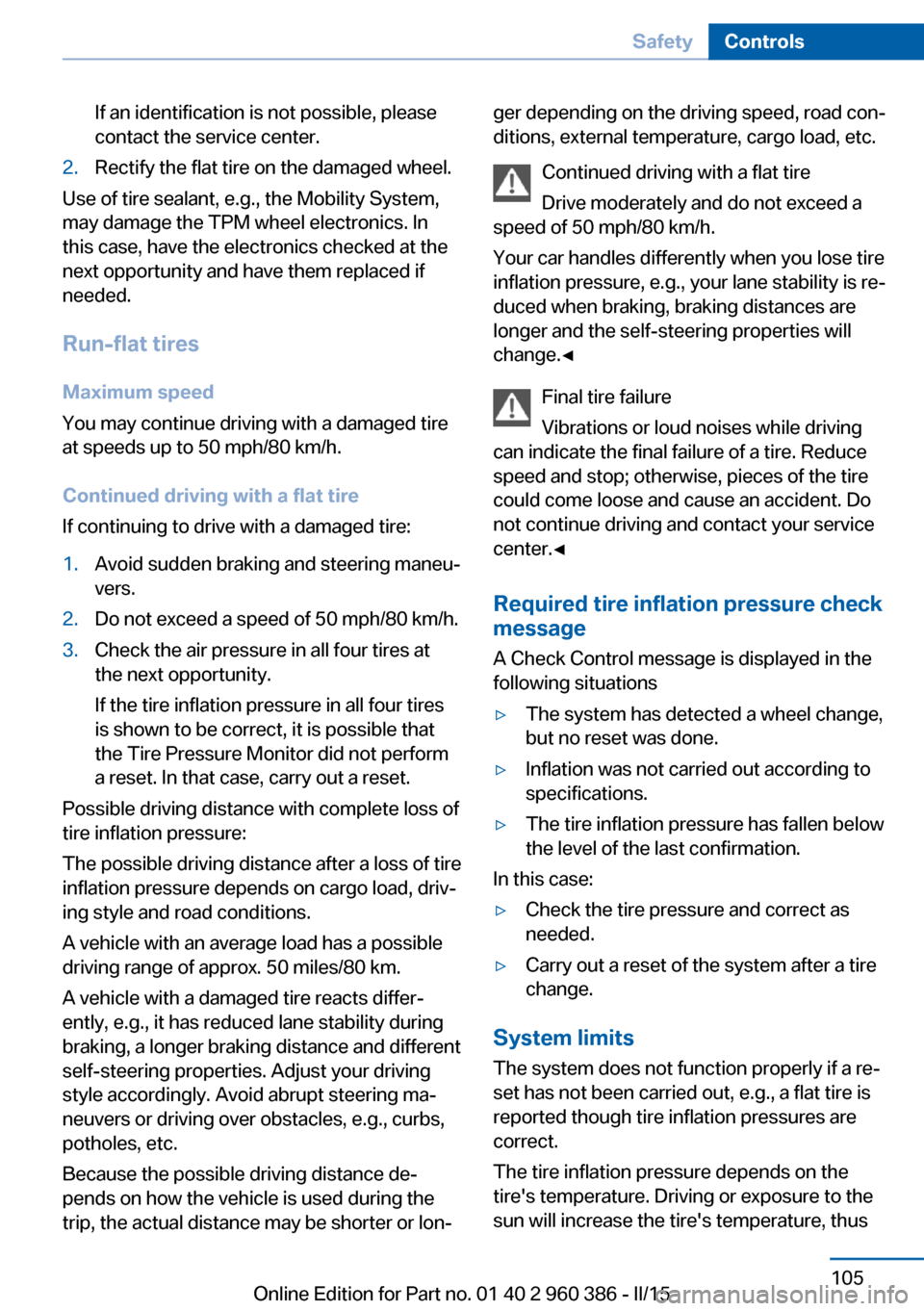
If an identification is not possible, please
contact the service center.2.Rectify the flat tire on the damaged wheel.
Use of tire sealant, e.g., the Mobility System,
may damage the TPM wheel electronics. In
this case, have the electronics checked at the
next opportunity and have them replaced if
needed.
Run-flat tires
Maximum speed
You may continue driving with a damaged tire
at speeds up to 50 mph/80 km/h.
Continued driving with a flat tire
If continuing to drive with a damaged tire:
1.Avoid sudden braking and steering maneuŌĆÉ
vers.2.Do not exceed a speed of 50 mph/80 km/h.3.Check the air pressure in all four tires at
the next opportunity.
If the tire inflation pressure in all four tires
is shown to be correct, it is possible that
the Tire Pressure Monitor did not perform
a reset. In that case, carry out a reset.
Possible driving distance with complete loss of
tire inflation pressure:
The possible driving distance after a loss of tire
inflation pressure depends on cargo load, drivŌĆÉ
ing style and road conditions.
A vehicle with an average load has a possible
driving range of approx. 50 miles/80 km.
A vehicle with a damaged tire reacts differŌĆÉ
ently, e.g., it has reduced lane stability during
braking, a longer braking distance and different
self-steering properties. Adjust your driving
style accordingly. Avoid abrupt steering maŌĆÉ
neuvers or driving over obstacles, e.g., curbs,
potholes, etc.
Because the possible driving distance deŌĆÉ
pends on how the vehicle is used during the
trip, the actual distance may be shorter or lonŌĆÉ
ger depending on the driving speed, road conŌĆÉ
ditions, external temperature, cargo load, etc.
Continued driving with a flat tire
Drive moderately and do not exceed a
speed of 50 mph/80 km/h.
Your car handles differently when you lose tire
inflation pressure, e.g., your lane stability is reŌĆÉ
duced when braking, braking distances are
longer and the self-steering properties will
change.ŌŚĆ
Final tire failure
Vibrations or loud noises while driving
can indicate the final failure of a tire. Reduce
speed and stop; otherwise, pieces of the tire
could come loose and cause an accident. Do
not continue driving and contact your service
center.ŌŚĆ
Required tire inflation pressure check
message
A Check Control message is displayed in the
following situationsŌ¢ĘThe system has detected a wheel change,
but no reset was done.Ō¢ĘInflation was not carried out according to
specifications.Ō¢ĘThe tire inflation pressure has fallen below
the level of the last confirmation.
In this case:
Ō¢ĘCheck the tire pressure and correct as
needed.Ō¢ĘCarry out a reset of the system after a tire
change.
System limits
The system does not function properly if a reŌĆÉ
set has not been carried out, e.g., a flat tire is
reported though tire inflation pressures are
correct.
The tire inflation pressure depends on the
tire's temperature. Driving or exposure to the
sun will increase the tire's temperature, thus
Seite 105SafetyControls105
Online Edition for Part no. 01 40 2 960 386 - II/15
Page 110 of 257
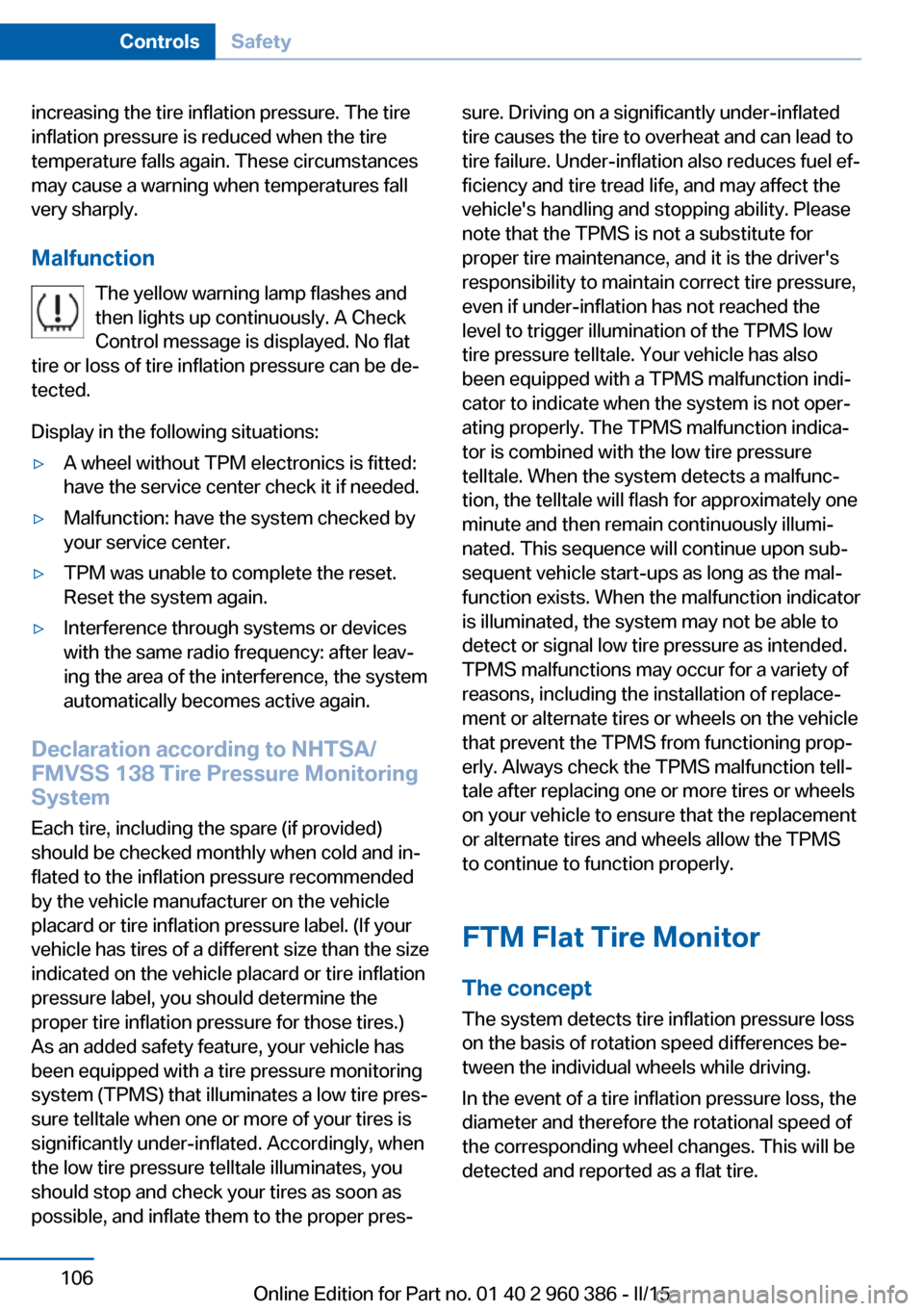
increasing the tire inflation pressure. The tire
inflation pressure is reduced when the tire
temperature falls again. These circumstances
may cause a warning when temperatures fall
very sharply.
Malfunction The yellow warning lamp flashes and
then lights up continuously. A Check
Control message is displayed. No flat
tire or loss of tire inflation pressure can be deŌĆÉ
tected.
Display in the following situations:Ō¢ĘA wheel without TPM electronics is fitted:
have the service center check it if needed.Ō¢ĘMalfunction: have the system checked by
your service center.Ō¢ĘTPM was unable to complete the reset.
Reset the system again.Ō¢ĘInterference through systems or devices
with the same radio frequency: after leavŌĆÉ
ing the area of the interference, the system
automatically becomes active again.
Declaration according to NHTSA/
FMVSS 138 Tire Pressure Monitoring
System
Each tire, including the spare (if provided)
should be checked monthly when cold and inŌĆÉ
flated to the inflation pressure recommended
by the vehicle manufacturer on the vehicle
placard or tire inflation pressure label. (If your
vehicle has tires of a different size than the size
indicated on the vehicle placard or tire inflation
pressure label, you should determine the
proper tire inflation pressure for those tires.)
As an added safety feature, your vehicle has
been equipped with a tire pressure monitoring
system (TPMS) that illuminates a low tire presŌĆÉ
sure telltale when one or more of your tires is
significantly under-inflated. Accordingly, when
the low tire pressure telltale illuminates, you
should stop and check your tires as soon as
possible, and inflate them to the proper presŌĆÉ
sure. Driving on a significantly under-inflated
tire causes the tire to overheat and can lead to
tire failure. Under-inflation also reduces fuel efŌĆÉ
ficiency and tire tread life, and may affect the
vehicle's handling and stopping ability. Please
note that the TPMS is not a substitute for
proper tire maintenance, and it is the driver's
responsibility to maintain correct tire pressure,
even if under-inflation has not reached the
level to trigger illumination of the TPMS low
tire pressure telltale. Your vehicle has also
been equipped with a TPMS malfunction indiŌĆÉ
cator to indicate when the system is not operŌĆÉ
ating properly. The TPMS malfunction indicaŌĆÉ
tor is combined with the low tire pressure
telltale. When the system detects a malfuncŌĆÉ
tion, the telltale will flash for approximately one
minute and then remain continuously illumiŌĆÉ
nated. This sequence will continue upon subŌĆÉ
sequent vehicle start-ups as long as the malŌĆÉ
function exists. When the malfunction indicator
is illuminated, the system may not be able to
detect or signal low tire pressure as intended.
TPMS malfunctions may occur for a variety of
reasons, including the installation of replaceŌĆÉ
ment or alternate tires or wheels on the vehicle
that prevent the TPMS from functioning propŌĆÉ
erly. Always check the TPMS malfunction tellŌĆÉ
tale after replacing one or more tires or wheels
on your vehicle to ensure that the replacement
or alternate tires and wheels allow the TPMS
to continue to function properly.
FTM Flat Tire Monitor The conceptThe system detects tire inflation pressure losson the basis of rotation speed differences beŌĆÉ
tween the individual wheels while driving.
In the event of a tire inflation pressure loss, the
diameter and therefore the rotational speed of
the corresponding wheel changes. This will be
detected and reported as a flat tire.Seite 106ControlsSafety106
Online Edition for Part no. 01 40 2 960 386 - II/15